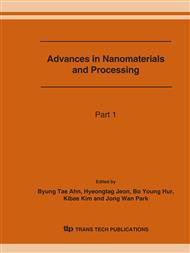p.1509
p.1513
p.1517
p.1521
p.1525
p.1529
p.1533
p.1537
p.1541
Aqueous Dispersion of ZrB2 Powder - Effect of Surface Corrosion and Dispersant
Abstract:
Hydrolysis and dispersing behavior of aqueous ZrB2 slurry were investigated. The isoelectric point (IEP) of ZrB2 slurry was measured to be pH 6.3. The acid and base slurry underwent rather rapid change of pH after fabrication for one and three hours, respectively. The oxygen content of the boride powder increased slowly with static ageing time in acid and neutral slurries, while the value decreased in base slurry. Application of poly(ethyleneimine) changed IEP of the boride slurry to pH 10.4. Sedimentation test informed that stability of the slurry was improved when increasing the molecular weight of poly(ethyleneimine) to 70,000 and in acid slurry (pH 3).
Info:
Periodical:
Pages:
1525-1528
Citation:
Online since:
June 2007
Authors:
Keywords:
Price:
Сopyright:
© 2007 Trans Tech Publications Ltd. All Rights Reserved
Share:
Citation:


